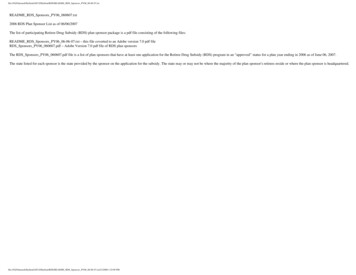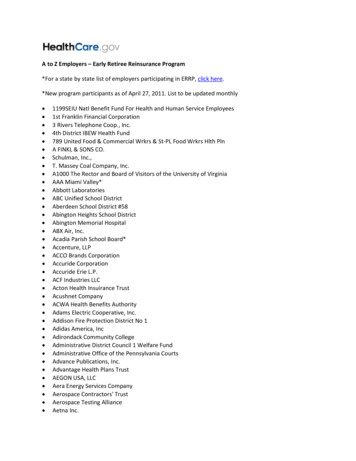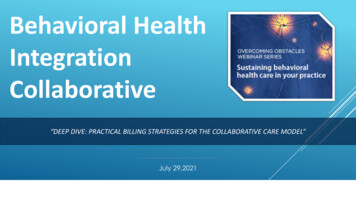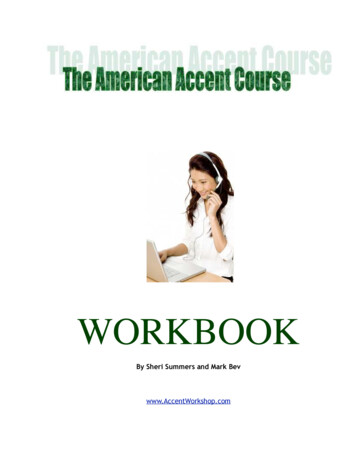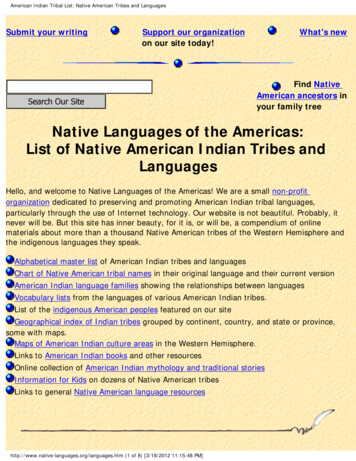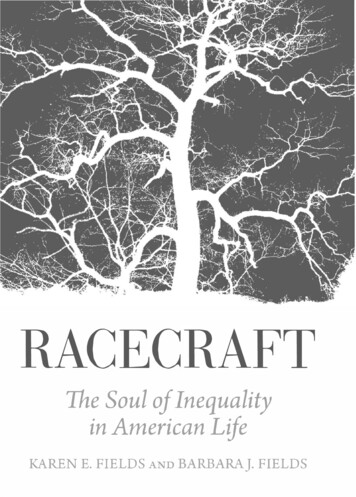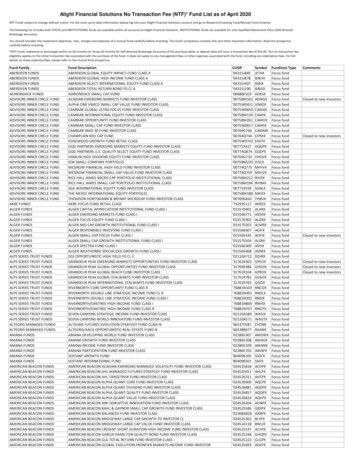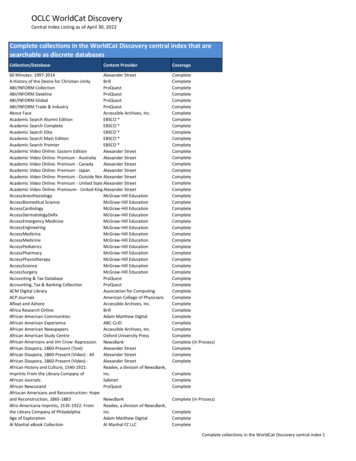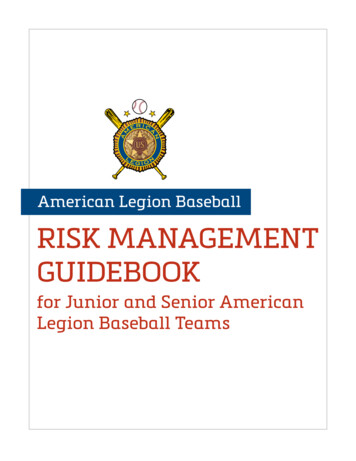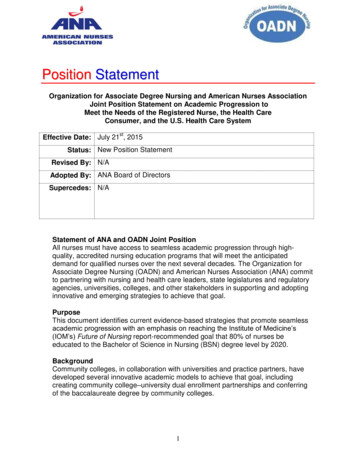
Transcription
Position StatementOrganization for Associate Degree Nursing and American Nurses AssociationJoint Position Statement on Academic Progression toMeet the Needs of the Registered Nurse, the Health CareConsumer, and the U.S. Health Care SystemstEffective Date: July 21 , 2015Status: New Position StatementRevised By: N/AAdopted By: ANA Board of DirectorsSupercedes: N/AStatement of ANA and OADN Joint PositionAll nurses must have access to seamless academic progression through highquality, accredited nursing education programs that will meet the anticipateddemand for qualified nurses over the next several decades. The Organization forAssociate Degree Nursing (OADN) and American Nurses Association (ANA) committo partnering with nursing and health care leaders, state legislatures and regulatoryagencies, universities, colleges, and other stakeholders in supporting and adoptinginnovative and emerging strategies to achieve that goal.PurposeThis document identifies current evidence-based strategies that promote seamlessacademic progression with an emphasis on reaching the Institute of Medicine’s(IOM’s) Future of Nursing report-recommended goal that 80% of nurses beeducated to the Bachelor of Science in Nursing (BSN) degree level by 2020.BackgroundCommunity colleges, in collaboration with universities and practice partners, havedeveloped several innovative academic models to achieve that goal, includingcreating community college–university dual enrollment partnerships and conferringof the baccalaureate degree by community colleges.1
In the early 1950s, Dr. Mildred Montag sought to alleviate a critical shortage ofnurses by decreasing the length of time for entry into practice. She advocatedreducing nursing education to 2 years by providing a strong educational base fornursing instruction and education in community and junior colleges. Dr. Montagproposed educating a technical nurse for 2 years to assist the professional nurse,whom she envisioned as having a baccalaureate degree. At the time, manypractitioners wanted to continue the 3-year, hospital-based diploma programs thatwere already educating the vast majority of nurses in the United States. Othersargued the BSN degree should be required for entering the nursing profession. Afew were interested in having nursing education take place in an academic settingbut did not think that 4 years of college were crucial for nurses to provide excellentpatient care. As a result, an Associate degree (AD) in nursing education expandedquickly across the United States as a means to educate the nursing workforce. Asthe number of AD programs was increasing, diploma programs began closing fornumerous reasons. (Appalachian State University, 2015).In 1964, the ANA House of Delegates adopted a motion that ANA “continue to worktoward baccalaureate education as the educational foundation for professionalnursing practice.” In 2000, the ANA Board of Directors reaffirmed that baccalaureateeducation should be the standard for entry into professional nursing practice (ANA,2000). The Tri-Council for Nursing—whose members are the ANA, AmericanAssociation of Colleges of Nursing (AACN), the American Organization of NurseExecutives (AONE), and the National League for Nursing (NLN)—issued a policystatement that supported a highly educated nursing workforce and that advocatededucational advancement of registered nurses as a critical component of safe andeffective patient care (Tri-Council of Nursing, 2010).The prestigious IOM issued The Future of Nursing: Leading Change, AdvancingHealth (2011), which is a blueprint for the future that offers a series ofrecommendations for how nurses’ roles, responsibilities, and education shouldchange to respond to a complex, evolving health care system and to changingpatient needs. Recommendations from the report focus on the intersection betweenhealth needs across the life span and the requisite skills and knowledge that nursesrequire to address those needs. One major recommendation identified that nursesshould achieve higher levels of education and training through an education systemthat promotes seamless academic progression. Specifically, the report recommendsincreasing the percentage of registered nurses (RNs) with a BSN degree to 80% bythe year 2020. Currently, 51% of nurses in the United States have a BSN degree,and 57% percent of nurses begin their nursing education at a community college,graduating with an associate degree (U.S. Department of Health and HumanServices, 2013).In response to the IOM report, the leaders of the AACN, the American Associationof Community Colleges (AACC), the Association of Community College Trustees(AACT), the NLN, and the National Organization for Associate Degree Nursing (NOADN, but now OADN) endorsed a shared goal of academic progression for all2
nursing students and graduates (N-OADN, 2012). The American Nurses Associationendorsed the statement in January 2013. In addition, the Robert Wood JohnsonFoundation (RWJF) developed an initiative to advance Academic Progression inNursing (APIN), thereby working with state-level Future of Nursing action coalitionsto identify best practices for achieving seamless academic progression and tobroadly disseminate those practices (RWJF, 2012).In 2013, RWJF convened a community college presidents’ meeting that includedcommunity college leaders from across the nation, Tri-Council for Nursing members,leaders from APIN, and other stakeholders to improve communication andcollaboration about academic progression through discussion of possible optionsand next steps. All attendees affirmed the valuable contribution of communitycolleges in providing opportunities for entry into the nursing workforce by individualswith diverse racial and ethnic backgrounds and socioeconomic statuses.Participants also agreed that best practices must be in place to support and promoteacademic progression across all levels from associate to doctoral degree. JohnLumpkin, MD, MPH, RWJF’s senior vice president, concurred: “Community collegeshave a role to play in preserving nursing as a profession. In partnership withcommunity colleges, we can influence social change” (RWJF, 2014a).A potential complicating factor in meeting the IOM recommendation is the registerednurse workforce projections. The Bureau of Labor Statistics has projected that555,100 RNs and advanced practice registered nurses (APRNs) will retire between2012 and 2022, and the demand for nurses will create 574,400 additional jobs forRNs and APRNs. The combination of those two forces will generate 1.13 millionvacancies for RNs and APRNs between 2012 and 2022 (ANA, 2014). Thevacancies, in turn, will create the need for additional faculty and classroom space tomeet the demand.DefinitionsFor purposes of this document, the following definitions are used:Academic Progression involves educational articulation models that promotelifelong learning through the attainment of academic credentials.Accreditation is the process of certification of competency, authority, or credibility.American Nurses Credentialing ProgramsMagnet RecognitionInstituted in 1994, the American Nurses Credentialing Center Magnet RecognitionProgram recognizes hospitals and health care systems that meet criteria andstandards for nursing excellence.Resource: ay to ExcellenceANCC’s Pathway to Excellence program recognizes health care and long-term3
care organizations that meet the criteria for a positive work environment and thatfoster and support excellent nursing practice.Resource: http://www.nursecredentialing.org/pathwayCommunity College Baccalaureate is a bachelor’s degree conferred by acommunity college that is authorized to do so.Competency-Based Curriculum is defined by the Learning Collaborative onAdvancing Education Transformation, which is part of the Center to ChampionNursing in America, as the process in which education partners, who generallyrepresent different educational approaches and backgrounds, develop a sharedunderstanding and a common goal and framework. The scope of the curriculumreaches beyond core competencies and focuses on knowledge, attitudes, and skillsthat encompass professional nursing practice. The curriculum is not standardized,but the model aims to reach standardized outcomes.Dual Enrollment is the concept of a student enrolling concurrently in two separateacademic institutions at the same time, often studying in two related programs.Nursing Accreditation is a voluntary specialized peer-reviewed process that isbased on identified standards and a system of assessment, evaluation, andcontinuous improvement. It serves as an assurance of quality educational standardsand outcomes.Seamless Academic Progression encompasses the concept of advancement fromone educational facility to another in an orderly and clearly charted plan so that onecan acquire sequential degrees without the repetition of coursework or cumbersomeprerequisite coursework.Statewide Curriculum Programs are educational collaboratives betweenuniversities and community colleges that enable students to transition automaticallyand seamlessly from an ADN to a BSN program, with all schools sharing curriculum,simulation facilities, and faculty. Faculty workload is reduced, and the schools makemore efficient and greater use of resources. Implementation of such programsrequires formal articulation agreements between community colleges anduniversities, adjustment of prerequisite and nursing curricula, and buy-in fromlegislative bodies and institutions.4
ReferencesAmerican Association of Colleges of Nursing. (2005). Baccalaureate nursingprograms offered by community colleges. Retrieved /ccbsnAmerican Association of Colleges of Nursing. (2013). Employment of new nursegraduates and employer preferences for baccalaureate-prepared nurses. Retrievedfrom http://www.aacn.nche.edu/leading initiatives news/news/2013/employment13American Nurses Association. (2000). ANA reaffirms commitment to BSN for entryinto practice (2/25). [News release.] Retrieved ttoBSN.aspxAmerican Nurses Association. (2014). Fast facts: The nursing workforce 2014.Retrieved acts-2014-Nursing-Workforce.pdfAmerican Nurses Credentialing Center. (2013). 2014 Magnet application manual.Silver Spring, MD: ANCC.Appalachian State University. (2014). The beginnings of associate degree nursingeducation in North Carolina. Retrieved associate-degree-nursing-educationncInstitute of Medicine. (2011). The future of nursing: Leading change, advancinghealth. Retrieved from ingLeading-Change-Advancing-Health.aspxNational Organization for Associate Degree Nursing. (2012). Joint statement onacademic progression for nursing students and graduates. Retrieved /140212 joint statement academic progression ana endorsed.pdfNational League for Nursing. (2012). Admissions to nursing programs: Disposition ofapplications to basic RN programs, fall 2012. Retrieved statistics/admissions-to-nursingprogramsRobert Wood Johnson Foundation. (2012). Future of nursing: Campaign for actionacademic progression in nursing. [Web page.] Retrieved fromhttp://campaignforaction.org/apin5
Robert Wood Johnson Foundation. (2014a). Summary of the 2013 communitypresidents’ meeting and progress in the year since it was convened. Retrieved roceedings.pdfRobert Wood Johnson Foundation. (2014b). Future of nursing: Campaign for actiondashboard indicators. [Web page.] Retrieved fromhttp://campaignforaction.org/dashboardRobert Wood Johnson Foundation (2015). Future of nursing: Campaign for action:Advancing nursing education/academic progression-promising educationprogression models. [Web page.] Retrieved ionTri-Council of Nursing. (2010). Consensus policy statement on the educationaladvancement of registered nurses. Retrieved ouncilEdStatement.pdfU.S. Department of Health and Human Services. (2013). The U.S. nursingworkforce: Trends in supply and education. Retrieved eport.pdf6
increasing the percentage of registered nurses (RNs) with a BSN degree to 80% by the year 2020. Currently, 51% of nurses in the United States have a BSN degree, and 57% percent of nurses begin their nursing education at a community college, graduating with an associate degree (U.S. Department of Health and Human Services, 2013).
